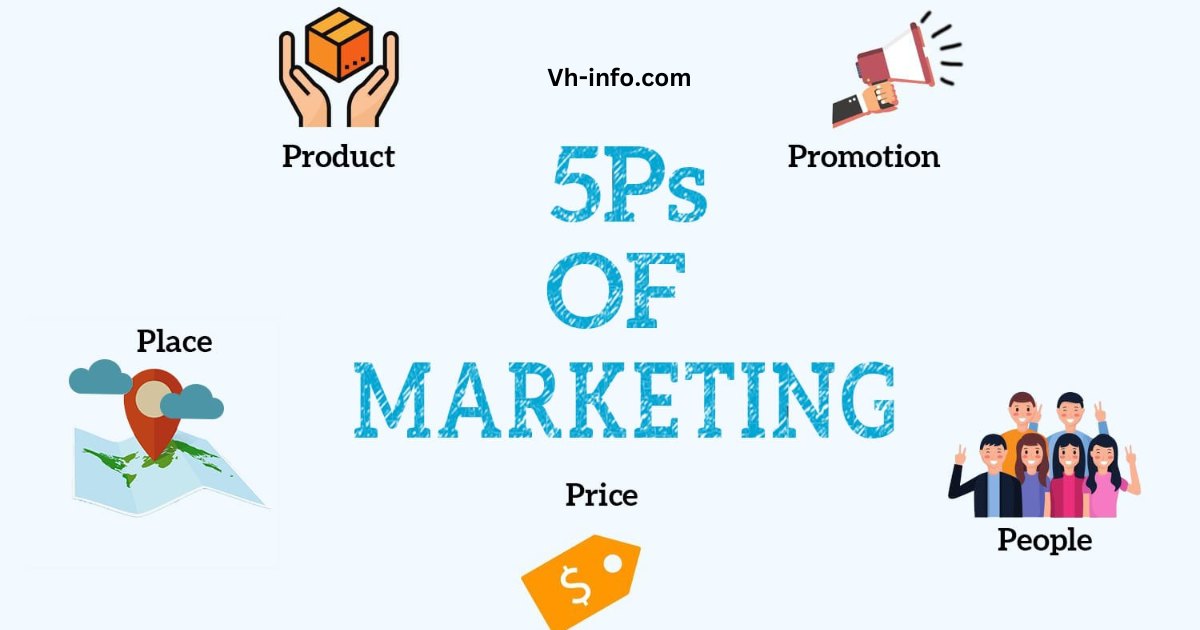Are you tired of your marketing campaigns not delivering the results you want?
Do you want to create a successful roadmap for your business?
The answer lies in the 5 Ps of Marketing. These five pillars of marketing, also known as the marketing mix, encompass all the elements that go into creating and promoting a product or service.
In this blog, we will dive deep into these five Ps – Product, Place, Price, Promotion, and People – and explore why they are crucial for any successful marketing campaign.
We will also discuss how to apply them effectively to your digital strategy and provide real-life examples from top brands like Apple, Nike, and Amazon.
So, let’s get started on creating a winning marketing plan using the 5 Ps of Marketing!
What Are the 5 Ps of Marketing?

The 5 Ps of marketing is super important for making marketing work well. It’s like a recipe that helps businesses sell their stuff better.
The recipe has 5 key ingredients: product, place, price, promotion, and people. These have been important for a long time, since the 1940s. But now, we also include “people” to make it even better. So, we call it the 5 Ps of marketing.
Let’s check out each of these ingredients more closely:
1. Product

The product part is about what a company sells to its customers. It’s not just the physical thing, but also how it looks, its brand, design, quality, features, and what benefits it gives. For startups, a no code MVP lets them build a product quickly without coding, making it easier to test ideas and gather feedback.
The aim is to make a product that satisfies what the customers want and need. It should also have something special that makes it better than what other companies are selling. For example, the Finntray product line by Kometos incorporates a dosing system that provides comprehensive dosing and packaging solutions tailored for the food industry. The system, designed to meet strict hygiene standards and minimize waste. So focusing on product prioritization will ensure that a company allocates resources efficiently to enhance its unique selling proposition and meet customer demands effectively.
For instance, a company might make its product stand out by focusing on high quality, having a unique design, or giving customers a really good experience. The brand (like the logo and name) is also super important in this part of marketing. Also, companies can invest in mockups to visually showcase their product’s quality, design, and brand identity.
2. Place

The “place” part is all about where customers can buy the product and how they get it. It includes things like where it’s sold, how it’s delivered, and the service level. such as same-day delivery options that can enhance customer satisfaction.
The idea is to make sure the product is easy for people to get, at the right time and place. This is really important to think about.
For example, a company might sell its product in different ways, like in physical stores, online shops, or directly to customers through distribution channels.
They also have to think about stuff like keeping enough products in stock, getting orders ready, and choosing good shipping options so that customers can get the product when and where they want, ensuring accessibility.
This includes utilizing various promotional activities such as social media ads, content strategies, and local craft fair events to build awareness around the business.
3. Price

The “price” part is all about how much customers have to pay for the product. It includes things like the cost of making the product, how much profit the company wants, and any special deals or discounts. To streamline and optimize this process, many companies leverage SAP CPQ solutions to automate pricing configurations, ensuring accuracy and efficiency in their pricing strategies.
The marketing plan should choose a price that is fair, competitive, and shows how valuable the product is. It also needs to help the business make the right amount of money. The price can affect how people see the product – whether it’s seen as affordable or fancy. So, it’s essential to also gather product feedback to see if there’s a need to lower the prices.
For example, a company might set a high price if they want to attract customers who are willing to pay more for something special. Or, they might set a low price to get more people to buy and try their product.
4. Promotion

“Promotion” is all about how a company tells people about its products or services. This includes things like ads, sales deals, talking to the media, personal selling, and using the internet. For example, crafting the right direct mail message can significantly improve response rates and boost engagement.
The aim is to make more people know about the product and get them interested enough to buy it. It’s like taking an extra step to convince people to choose and buy what you’re selling.
For instance, a company might use social media to make more people recognize its brand, give out discount codes to boost sales, or team up with a famous person or influencer to talk about and recommend the product.
5. People

Last but very important, the “people” part is all about the individuals who are part of making, selling, and using the product or service. This includes the workers, customers, suppliers, and partners.
A business needs good relationships with these people. It’s important to make sure everyone’s needs and wants are taken care of.
For instance, a company might spend on training and developing its employees to make its product or service better. It could also listen to what customers have to say to make improvements and fix any problems.
From making sure the employees are happy to looking at what customers think, people are at the heart of every business.
Other Marketing Mix Ps
The 5 Ps of marketing give a strong base for a good marketing plan. But, depending on the type of business, marketers might want to think about a few more Ps to make sure they cover everything.
Here are some extra Ps that can make your marketing plan even better:
Process

How you get your products or services to customers is really important for your marketing plan. The process is about how you make and deliver what you’re offering to customers. This includes not only choosing the right channels but also tracking operational expenses to ensure that your delivery methods remain efficient and cost-effective.
This part can help you figure out the best way to give your products or services to the people you want to reach.
Physical Evidence

This part is about the real things in your products or services that customers can touch or have.
It could be something like an actual item, for example, a car, or something digital, like software. The physical evidence is like proof that the customer got what you offered.
Partners

If you work with friends like distributors or other marketing buddies, adding them to your marketing plan is really important.
This part helps you find and make partnerships that can help you reach more people, make your customer service better, and bring in more money overall.
Payment

Payment is about how you handle and deal with buying and paying for things. It’s like figuring out how customers can pay you.
This can be through cash, credit cards, or online payment platforms. Finding the best ways for customers to pay can make their experience better and make your business run smoother.
Packaging

Packaging is how your products or services look on the outside.
If it looks good, it can make your brand better, make your products stand out from others, and even make more people want to buy them.
Perception

How people see and think about your brand is really important in today’s digital marketing.
This part helps you figure out what people think about your brand and make changes to make it better and give customers a good experience.
Why are the 5Ps of Marketing important?
The 5 Ps of marketing are like a guide to help business owners know their customers and sell things better. They help in figuring out who the best customers are and how to reach them using time and money wisely. If any of these parts doesn’t match what the customer wants, the product or service might not do well. These principles can be used for the whole business or for specific things like ads or launching a new product.
Who invented the 5 Ps of marketing?
The person who came up with the 5 Ps of marketing is Philip Kotler. He’s a smart professor of international marketing at Northwestern University. He’s famous for making the idea of the marketing mix popular.
Why are the 5 Ps of Marketing Important to Your Digital Strategy?
The 5 Ps of marketing are super important for your digital strategy because they help you stay focused on what you want to achieve. They create a plan that guides all your efforts.
When you have these pillars in place, it’s easier to see where your business might need some extra help. For instance, if you’re having trouble selling things, you might want to check the prices or the people handling sales.
And, if your new products or services aren’t getting good reviews, it’s time to dig into your product lines and see if they’re reaching the right people.
No matter what challenges your business is facing, having these core values is like a compass that helps everyone stay on track and work towards the same goals.
How to Use 5 Ps of Marketing Effectively?
Now that you know about the 5 Ps of Marketing, let’s talk about how to make them work well for your business:
- Create a Buyer Persona: Start by figuring out who your customers are. Make a “buyer persona” to understand what they need. This will help you use the 5 Ps to give them what they want.
- Define a Strategy: Use the 5 Ps to plan how to meet your customer’s needs and reach your business goals. Remember, all your 5 Ps of Marketing are connected.
- Mind Your 5 Ps in Content: When making things like blog posts, Facebook ads, or Instagram reels & stories, think about your 5 Ps. Ask yourself, “How does this help my customers, and how does it connect to my 5 Ps?“
- Watch How Your Ps Affect Each Other: Pay attention to how one P can affect another. If you change the price, it might change how many people want it. Think about this to adjust your 5 Ps of Marketing plan.
- Use Analytics and Data: Look at data like website visits, sales, and other numbers to guide your 5 Ps. This will help you know what changes will work best for your 5 Ps of Marketing. Additionally, by transferring data from Amazon RDS to BigQuery, you can gain deeper insights into your business performance, analyze large datasets efficiently, uncover trends, and make data-driven decisions that optimize your marketing strategies.
Examples From Real Brands of the 5 Ps of Marketing
Let’s check out some examples of the 5 Ps of marketing to learn more about them.
Canva

Canva is a cool and different platform. It lets people who aren’t experts in design make marketing stuff easily. When Canva started, it was free. Once people liked it, Canva added special paid versions with extra features for businesses. It lets people who aren’t experts in design make marketing stuff easily as it offers various pre-made customizable templates such as flyer templates, brochure templates, and many more.
They were careful about when to add these features so that people still felt the price was fair and worth it.
Mercaris

Mercaris is a financial tech company that saw something missing in how it sold its product. They decided to focus on organic, non-GMO, and sustainable agriculture. This made their brand stand out because there weren’t as many companies doing the same thing.
By making a product in a niche area with less competition, Mercaris found its own spot in the market. They kind of created their own special place where they could be the best.
Tesla

Tesla is changing how cars work with its electric vehicles. It’s not just about cars; it’s also about making the future better.
The ‘Price‘ for Tesla cars might be higher, but that’s because they use really advanced tech and give a luxury experience.
For ‘Place,’ Tesla does things differently by selling directly to customers online or in their showrooms, not through regular car dealerships.
In ‘Promotion,’ Tesla relies a lot on public relations, spearheaded by CEO Elon Musk’s influential presence on social media.
Lastly, the ‘People‘ at Tesla, from the engineers to the salespeople, all believe in making the world greener, giving a personal touch to the brand.
Warby Parker

Warby Parker, the online glasses company, sells frames for only $95. This is way less than what many other companies charge.
They decided on this price by thinking about what people see as both cheap and good quality. So, Warby Parker found a price that works well for their product.
By paying attention to what people think and setting the right price, Warby Parker reached its goals of being affordable but still seeming like a high-quality brand.
Apple

Apple is really smart in how they use the 5 Ps of marketing to build brand awareness known for innovation and luxury.
They put a lot of emphasis on the ‘Product.’ All Apple devices are made to be easy to use, stylish, and give users a great experience.
For ‘Price,’ Apple charges a bit more than other brands, but people think it’s worth it for the quality they get.
Their ‘Place‘ is in cool and modern stores that match their brand look.
In ‘Promotion,’ Apple focuses on emotions, showing how their products make life better.
The ‘People‘ at Apple, from the leaders to the store staff, play a big part in making and keeping Apple as a top brand.
Hu

Hu is a dessert brand that makes organic treats without lots of extra stuff you find in regular candy and chocolate.
But instead of being a special brand that you can only find online, Hu put its products in big stores like Whole Foods, Target, and Walmart.
By doing that, more people could easily buy their products. Hu became more known, and more people bought their treats.
The Lip Bar

The Lip Bar is a famous vegan beauty brand that works with popular people on social media to tell more people about its products.
They focus on women of color in their marketing and carefully pick partners who believe in what they stand for.
By promoting the brand on social media and through influencers, The Lip Bar reaches the people they want to connect with, right where those people hang out.
Walmart

Walmart’s plan with the 5 Ps is all about giving you good value for your money. They have a huge range of stuff (‘Product‘) for pretty much everything you might need. Walmart keeps prices low every day (‘Price‘) to attract people who are careful with their money.
They have lots of stores and a website (‘Place‘) so you can easily get their products. Walmart tells you about their deals and discounts through flyers and special campaigns (‘Promotion‘).
The people who work at Walmart (‘People‘) are important in making sure you get friendly service and are happy with what you buy. They play a big part in keeping the promise of good customer service.
Nike

Nike’s plan in the 5 Ps is all about inspiring people and making things that work well. They offer more than just shoes (‘Product‘); they have clothes and accessories too, all made to make sports better and look good.
The prices are a bit high (‘Price‘) because their stuff is really well designed and made with top-quality materials. You can get Nike things in their stores, online, and in certain sports shops (‘Place‘).
To get people excited, Nike uses famous people and cool stories (‘Promotion‘). The people who work at Nike, from those who design to those in the stores (‘People‘), are all about what Nike stands for, making the brand even more appealing.
Starbucks

Starbucks uses the 5 Ps to make a special coffee experience. They offer more than just coffee (‘Product‘); they have lots of drinks, food, and even things with their brand on them.
Starbucks prices are often a bit higher than other places (‘Price‘), but people are okay with it because they like the unique atmosphere and good quality.
Starbucks picks where to put their stores carefully for lots of people to see (‘Place‘). They do promotions with special drinks, loyalty programs, and are active on social media (‘Promotion‘). The people who work at Starbucks, called ‘partners,’ are friendly and make sure customers feel at home (‘People‘). This makes Starbucks like a second home between work and home, attracting and keeping loyal customers.
Amazon

Amazon uses the 5 Ps to stay the biggest online marketplace. They sell almost everything you can think of (‘Product‘). Amazon keeps prices competitive and changes them based on what’s happening, and if you’re a Prime member, you might get free shipping (‘Price‘).
Shopping on Amazon is easy online, and they have a big network to deliver things fast (‘Place‘). They suggest things you might like and show you ads (‘Promotion‘). You can leverage Amazon FBA Prep as well to manage your inventory better and ship products efficiently.
The people at Amazon, from those in the warehouse to those working on fancy tech like AI, all work to make Amazon the most customer-friendly company on Earth (‘People‘). Their vast logistics network ensures quick delivery and efficient operations. When considering selling products on Amazon, it’s essential to factor in Amazon RDS pricing to optimize costs and enhance profitability.
YouTube

YouTube, the online platform, does things a bit different with the 5 Ps.
The ‘Product‘ is the platform where people can share and watch videos.
‘Price‘ is not for viewers; they can watch for free. But advertisers pay to show their ads to the right people. It’s online, so you can use it anywhere with internet (‘Place‘). ‘Promotion‘ includes features like showing videos they think you’ll like.
‘People‘ include everyone – from the people making videos to those who keep the tech working well, including influencers on LinkedIn.
Netflix

Netflix changed how we have fun by using the 5 Ps. They have a bunch of stuff to watch (‘Product‘), including lots of their own shows and movies. You can choose how much you want to pay with different plans (‘Price‘).
You can watch Netflix online anytime, anywhere (‘Place‘). They tell you about what to watch with personalized suggestions, social media, and exciting trailers (‘Promotion‘).
People at Netflix, like those who make shows, look at data, and fix tech stuff, all work together to give you an amazing time with entertainment (‘People‘).
FAQ’s:
Which P is the most important?
It’s difficult to say that any one P is definitively the most important, as the 5 Ps are interrelated and depend on each other.
However, Product functionality and People are often seen as the most critical key features. A strong, differentiated product that solves customer needs is the foundation. And having the right people and talent to execute the Product, Pricing, Promotion, and Place is vital for success.
While the importance of each P varies by company, Product functionality and People are essential for any marketing strategy. But ideally all 5 Ps work together to create an integrated, customer-focused marketing mix.
Is the 5 P’s necessary to develop a good marketing plan?
The 5 P’s – Product, Price, Place, Promotion, and People – provide a useful framework for developing a strong marketing plan.
Considering each P helps you thoroughly think through your strategy and tactics. While not strictly necessary, the 5 P’s cover the key elements of a good marketing plan.
How the 5 Ps of marketing can be used to create successful marketing strategies?
The 5 Ps of marketing – Product, Price, Place, Promotion, People, and Target Market – provide a framework to develop strategies that align your product/service, pricing, distribution, messaging, and staffing.
Carefully considering each P, including product decisions, allows you to create an integrated strategy that meets customer needs, delivers value, reaches your target audience, and leverages your team’s skills.
This comprehensive approach, including market coverage, is key to creating marketing strategies that connect with customers and drive success.
Can the 5 Ps of marketing be applied to all types of businesses?
Yes, the 5 Ps of marketing – Product, Price, Place, Promotion, and People – provide a versatile framework that can be applied to all types of businesses.
The key elements of product, pricing, distribution, marketing communications, and staffing are relevant for any company selling products or services.
While the specifics will differ, considering each P allows any business to develop an integrated marketing strategy.
The 5 Ps framework, introduced by E. Jerome McCarthy, is flexible enough to help small startups or large corporations create strategies for success.
Does the importance of each P vary across different industries or sectors?
Yes, the importance of each of the 5 Ps – Product, Price, Place, Promotion, and People – does vary depending on the industry or sector.
For example, Price may be a critical factor for low-cost airlines, while Promotion is more important in building luxury brands. Place or distribution, or the right place, is a key P for consumer packaged goods.
The flexibility of the 5 Ps framework allows marketers to emphasize the most relevant elements for their specific company and market dynamics. While all 5 Ps matter, businesses can leverage the framework to focus on their most vital marketing mix ingredients.
Can a business still succeed without incorporating all 5 Ps in their marketing strategy?
A business needs to consider all 5 Ps, including the people element, for marketing success. Each P is important, but their relevance may vary for different businesses.
By thoroughly addressing the most relevant Ps for your market, product, and business model, you can succeed with a focused marketing mix.
However, incorporating all 5 Ps provides the best opportunity to connect with customers and outperform competitors.
Leverage the 5 Ps of Marketing Framework to Develop an Integrated Strategy
The 5 Ps of Marketing – Product, Price, Place, Promotion, and People provide a comprehensive framework for marketing success.
Carefully researching your target audience using qualitative methods and segmentation strategies allows you to differentiate your offering and market positioning.
You can then reach both TOFU and BOFU prospects through appropriate channels. Financial services in particular depend on effective positioning to attract clients.
Using keyword outlines further helps refine messaging. With careful attention to each P, an integrated marketing strategy can be developed.
Conclusion
In conclusion, the 5 Ps of marketing provide a comprehensive roadmap to success in your marketing efforts. Each P plays a vital role in shaping your marketing strategy and ensuring its effectiveness.
From developing a compelling product to identifying the right target audience, setting the right price, promoting effectively, and creating a positive customer experience, all these elements work together to drive your marketing success.
It’s important to remember that the 5 Ps are not static; they require continuous evaluation and adaptation to meet the changing needs of your business and the market.
By understanding and effectively applying the 5 Ps, you can create a strong foundation for your marketing efforts and achieve your business goals.



